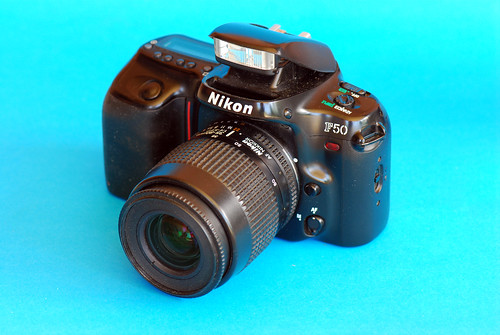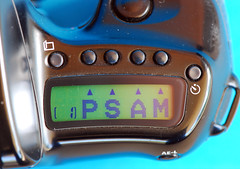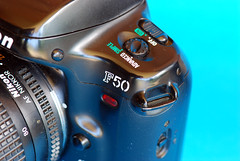Difference between revisions of "Nikon F50 (N50)"
Hanskerensky (talk | contribs) (Now Category:Nikon F mount|F50) |
|||
| (12 intermediate revisions by 5 users not shown) | |||
| Line 1: | Line 1: | ||
__NOTOC__ | __NOTOC__ | ||
| − | + | {{Flickr_image | |
| + | |image_source= http://www.flickr.com/photos/heritagefutures/6334144544/in/pool-camerawiki | ||
| + | |image= http://farm7.static.flickr.com/6050/6334144544_84a0777e89.jpg | ||
| + | |image_align= right | ||
| + | |image_text= Nikon F50 | ||
| + | |image_by= Dirk HR Spennemann | ||
| + | |image_rights= with permission | ||
| + | }} | ||
| − | The F50 features autofocus, [[Through-the-lens | + | The '''F50''', sold as the '''N50''' in the United States, was an entry-level [[135 film|35mm film]] [[SLR|Single-lens reflex camera]] which was introduced by [[Nikon]] in 1994. It was aimed at the lower-end of the amateur [[autofocus]] SLR market. |
| + | |||
| + | The F50 features autofocus, [[TTL|Through-the-lens]] light metering and various "programs" (ranging from manual operation to a highly-automated [[Point and shoot|point and shoot]] mode). A variant known as the '''F50D / N50D''', which added a date/time-imprinting facility and also panoramic mode. The F50 body was made from polycarbonate and metal, and available in both "champagne silver" and black. It is similar to Nikon's other consumer film SLRs from its era, giving the usual P/S/A/M modes. Notable omissions include depth-of-field preview and any form of remote shutter release | ||
The F50 was replaced by the similarly-priced [[Nikon F60 (N60)|F60/N60]] in 1998. | The F50 was replaced by the similarly-priced [[Nikon F60 (N60)|F60/N60]] in 1998. | ||
| − | ====Specifications==== | + | {|class=plainlinks align=center |
| + | || | ||
| + | {{Flickr_image | ||
| + | |image_source= http://www.flickr.com/photos/heritagefutures/6334134388/in/pool-camerawiki | ||
| + | |image= http://farm7.static.flickr.com/6227/6334134388_333fec7795_m.jpg | ||
| + | |image_align= center | ||
| + | |image_by= | ||
| + | |image_rights= | ||
| + | }} | ||
| + | || | ||
| + | {{Flickr_image | ||
| + | |image_source= http://www.flickr.com/photos/heritagefutures/6333389447/in/pool-camerawiki | ||
| + | |image= http://farm7.static.flickr.com/6115/6333389447_c6194b5487_m.jpg | ||
| + | |image_align= center | ||
| + | |image_by= | ||
| + | |image_rights= | ||
| + | }} | ||
| + | || | ||
| + | {{Flickr_image | ||
| + | |image_source= http://www.flickr.com/photos/heritagefutures/6334142518/in/pool-camerawiki | ||
| + | |image= http://farm7.static.flickr.com/6225/6334142518_fd644a6de8_m.jpg | ||
| + | |image_align= top | ||
| + | |image_by= | ||
| + | |image_rights= | ||
| + | }} | ||
| + | |- | ||
| + | |colspan=3 align="center"| | ||
| + | {{Flickr_image_caption | ||
| + | |image_text= Nikon F50 | ||
| + | |image_by= Dirk HR Spennemann | ||
| + | |image_rights= with permission | ||
| + | }} | ||
| + | |} | ||
| + | ==Specifications== | ||
| + | {|class=plainlinks align=right | ||
| + | || | ||
| + | {{Flickr_image | ||
| + | |image_source= http://www.flickr.com/photos/camera_collector/4625677356/in/pool-camerawiki/ | ||
| + | |image= http://farm5.staticflickr.com/4044/4625677356_00e2359543_m.jpg | ||
| + | |image_align= right | ||
| + | |image_text= N50 | ||
| + | |image_by= Jay Cox | ||
| + | |image_rights= wp | ||
| + | }} | ||
| + | |- | ||
| + | || | ||
| + | {{Flickr_image | ||
| + | |image_source= http://www.flickr.com/photos/vagn49/13798272043/in/pool-camerawiki/ | ||
| + | |image= http://farm4.staticflickr.com/3827/13798272043_d96bc734ae_m.jpg | ||
| + | |image_align= right | ||
| + | |image_text= quartz date | ||
| + | |image_by= Vagn Sloth-Madsen | ||
| + | |image_rights= nc | ||
| + | }} | ||
| + | |} | ||
Nikon F50/N50 Major Specifications: | Nikon F50/N50 Major Specifications: | ||
* Format: 24 x 36mm [[135 film | standard 35mm (135) film format]] | * Format: 24 x 36mm [[135 film | standard 35mm (135) film format]] | ||
| Line 13: | Line 76: | ||
* Shutter: Electronically controlled vertical-travel focal-plane shutter; 1/2000 sec. to 30 sec. | * Shutter: Electronically controlled vertical-travel focal-plane shutter; 1/2000 sec. to 30 sec. | ||
* Focus: Auto Focus / Manual Focus | * Focus: Auto Focus / Manual Focus | ||
| − | * ISO: ISO 25 to 5000 for DX coded film; ISO 6 to 6400 for non-DXcoded films in Advanced mode | + | * ISO: ISO 25 to 5000 for [[DX Encoding|DX coded]] film; ISO 6 to 6400 for non-DXcoded films in Advanced mode |
* Modes: P/S/A/M | * Modes: P/S/A/M | ||
* Display: LCD | * Display: LCD | ||
| − | * Batteries: 6V lithium battery pack (2CR5 or DL245 type) | + | * Batteries: 6V lithium battery pack ([[2CR5 battery|2CR5]] or DL245 type) |
* Dimensions: 149 x 96 x 70mm; weight approx. 580g. | * Dimensions: 149 x 96 x 70mm; weight approx. 580g. | ||
| Line 22: | Line 85: | ||
* [http://www.mir.com.my/rb/photography/companies/nikon/htmls/models/specroom98/f50/f50spec.htm Nikon F50 / N50 Technical Specifications] at Photograph in Malaysia. | * [http://www.mir.com.my/rb/photography/companies/nikon/htmls/models/specroom98/f50/f50spec.htm Nikon F50 / N50 Technical Specifications] at Photograph in Malaysia. | ||
* [http://www.butkus.org/chinon/nikon/nikon_n50/nikon_n50.htm Manual for the F50] at Mike Butkus's [http://www.butkus.org/chinon/ OrphanCameras.com] | * [http://www.butkus.org/chinon/nikon/nikon_n50/nikon_n50.htm Manual for the F50] at Mike Butkus's [http://www.butkus.org/chinon/ OrphanCameras.com] | ||
| − | + | ||
| − | + | {{Nikon 35mm SLR}} | |
| + | [[Category: Japanese 35mm autofocus SLR]] | ||
| + | [[Category:Nikon F mount|F50]] | ||
| + | [[Category:F|F50 Nikon]] | ||
| + | [[Category: N]] | ||
Latest revision as of 06:46, 13 December 2021

|
| Nikon F50 image by Dirk HR Spennemann (Image rights) |
The F50, sold as the N50 in the United States, was an entry-level 35mm film Single-lens reflex camera which was introduced by Nikon in 1994. It was aimed at the lower-end of the amateur autofocus SLR market.
The F50 features autofocus, Through-the-lens light metering and various "programs" (ranging from manual operation to a highly-automated point and shoot mode). A variant known as the F50D / N50D, which added a date/time-imprinting facility and also panoramic mode. The F50 body was made from polycarbonate and metal, and available in both "champagne silver" and black. It is similar to Nikon's other consumer film SLRs from its era, giving the usual P/S/A/M modes. Notable omissions include depth-of-field preview and any form of remote shutter release
The F50 was replaced by the similarly-priced F60/N60 in 1998.
|
|
| ||||||
|
Nikon F50 | ||||||||
Specifications
| ||
|
Nikon F50/N50 Major Specifications:
- Format: 24 x 36mm standard 35mm (135) film format
- Lens mount: Nikon F mount
- Lens: kit lenses AF Nikkor 35-80mm f/4-5.6 D and AF Nikkor 80-200mm f/4.5-5.6D.
- Shutter: Electronically controlled vertical-travel focal-plane shutter; 1/2000 sec. to 30 sec.
- Focus: Auto Focus / Manual Focus
- ISO: ISO 25 to 5000 for DX coded film; ISO 6 to 6400 for non-DXcoded films in Advanced mode
- Modes: P/S/A/M
- Display: LCD
- Batteries: 6V lithium battery pack (2CR5 or DL245 type)
- Dimensions: 149 x 96 x 70mm; weight approx. 580g.
Links
- Nikon F50 / N50 Technical Specifications at Photograph in Malaysia.
- Manual for the F50 at Mike Butkus's OrphanCameras.com
| Nikon 35mm SLR Cameras | |
|---|---|
| Nikkorex F | Nikon EL2 | Nikon EM | Nikon F | Nikon F2 | Nikon F3 | Nikon F4 | Nikon F5 | Nikon F6 | Nikon F50 | Nikon F55 | Nikon F60 | Nikon F65 | Nikon F70 | Nikon F75 | Nikon F80 | Nikon F90 | Nikon F90X | Nikon F100 | Nikon F-301 | Nikon F-401 | Nikon F-401S | Nikon F-401X | Nikon F-501 | Nikon F-601 | Nikon F-601M | Nikon F-801 | Nikon F-801s | Nikon FA | Nikon FE | Nikon FE2 | Nikon FE10 | Nikon FG | Nikon FG-20 | Nikon FM | Nikon FM2 | Nikon FM2n | Nikon FM3A | Nikon FM10 | |
| Nikomat / Nikkormat | |
| EL | EL2 | ELW | FS | FT | FT2 | FT3 | FTN | |




